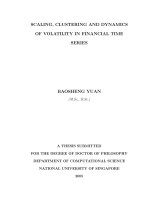Management ch 14 dynamics of behavior in organizations
Bạn đang xem bản rút gọn của tài liệu. Xem và tải ngay bản đầy đủ của tài liệu tại đây (499.85 KB, 33 trang )
Chapter 14
Dynamics of Behavior in
Organizations
Dynamics of Behavior in Organizations
Managers need to understand the way individuals & groups act
Employees and managers bring their individual
differences to work each day
Differences in attitudes, values, personality, and
behavior influence
–
how people interpret an assignment,
–
whether they like to be told what to do
–
how they handle challenges
–
how they interact with others
Manager’s Challenge: Quick Eagle
Networks
2
Copyright © 2005 by South-Western, a division of Thomson Learning. All rights reserved.
Dynamics of Behavior
in Organizations
3
Attitudes
Personality
Perception
Learning
Stress management
Copyright © 2005 by South-Western, a division of Thomson Learning. All rights reserved.
Topics
Chapter 14
Organizational Behavior
Commonly called OB
•
Interdisciplinary field dedicated to the study of
attitudes
behavior
performance
4
Copyright © 2005 by South-Western, a division of Thomson Learning. All rights reserved.
Interdisciplinary Influences on
Organizational Behavior
Economics
Cultural Anthropology
Management
Sociology
Psychology
5
Vocational Counseling
Organizational
Behavior
Copyright © 2005 by South-Western, a division of Thomson Learning. All rights reserved.
Ethics
Industrial
Engineering
Organizational Citizenship
6
Work behavior that goes beyond job requirements and
contributes as needed to the organization’s success
●
Being helpful to coworkers and customers
●
Doing extra work when necessary
●
Looking for ways to improve products & procedures
Copyright © 2005 by South-Western, a division of Thomson Learning. All rights reserved.
Attitudes
Cognitive and affective evaluation that predisposes a person to
act in a certain way
Attitudes determine how people
–
–
–
7
Perceive the work environment
Interact with others
Behave on the job
Copyright © 2005 by South-Western, a division of Thomson Learning. All rights reserved.
or
Components of an Attitude
8
Copyright © 2005 by South-Western, a division of Thomson Learning. All rights reserved.
Components of Attitudes
Particularly important when attempting to change attitudes
9
Cognitive component includes the beliefs, opinions, and
information the person has about the object of the attitude
Affective component is the person’s emotions or feelings about
the object of the attitude
Behavioral component of an attitude is the person’s intention to
behave toward the object of the attitude in a certain way
Copyright © 2005 by South-Western, a division of Thomson Learning. All rights reserved.
High-Performance Work Attitudes
Two
attitudes that might
relate to high performance
–
Job Satisfaction
–
Organizational Commitment
Managers of today’s knowledge workers often rely on
job satisfaction to keep motivation and enthusiasm for
the organization high
10
Copyright © 2005 by South-Western, a division of Thomson Learning. All rights reserved.
High-Performance Work Attitudes
11
Job Satisfaction = positive attitude toward one’s job
Organizational Commitment = loyalty to and heavy
involvement in one’s organization
Copyright © 2005 by South-Western, a division of Thomson Learning. All rights reserved.
Conflicts Among Attitudes
Cognitive Dissonance = condition in which two attitudes or a
behavior and an attitude conflict
–
–
–
12
Leon Festinger – 1950s
People want to behave in accordance with their
attitudes
Usually will take corrective action
Copyright © 2005 by South-Western, a division of Thomson Learning. All rights reserved.
Perception
13
Cognitive process people use to make sense out of the
environment by
●
Selecting
●
Organizing
●
Interpreting information
Copyright © 2005 by South-Western, a division of Thomson Learning. All rights reserved.
Perception
Perception Process: Cognitive process
used to make sense out of the
environment (3 steps)
Observe information via senses
Screen information & select what to
process
Organize selected data into patterns
Perceptual Selectivity:
process by which individuals
screen and select various
stimuli that vie for their
attention
Primacy (toward beginning)
Recency (toward end of event)
Perceptual Distortions: errors in perceptual
judgment arising from inaccuracies in any part
of the perceptual process
Common Errors:
Stereotyping
Halo effect
Projection
14
Copyright © 2005 by South-Western, a division of Thomson Learning. All rights reserved.
Common Perceptual
Distortions
15
Stereotyping
Tendency to assign an individual to a group or
broad category and then attribute generalizations
about the group to the individual
Copyright © 2005 by South-Western, a division of Thomson Learning. All rights reserved.
Common Perceptual
Distortions
16
Halo
Effect
Overall impression of a person or situation based on
one characteristic, either favorable or unfavorable
Copyright © 2005 by South-Western, a division of Thomson Learning. All rights reserved.
Common Perceptual
Distortions
17
Tendency to see
one’s own personal
traits in other people
Copyright © 2005 by South-Western, a division of Thomson Learning. All rights reserved.
Projection
Common
Perceptual
Distortions
18
Perceptual
Defense
Tendency of perceivers to protect themselves by
disregarding ideas objects, or people that are
threatening to them
Copyright © 2005 by South-Western, a division of Thomson Learning. All rights reserved.
Attributions
19
Judgments about what caused a person’s behavior—either
characteristics of the person or of the situation
As people organize what they perceive, they often draw
conclusions
Copyright © 2005 by South-Western, a division of Thomson Learning. All rights reserved.
External or Internal Attributions
20
Copyright © 2005 by South-Western, a division of Thomson Learning. All rights reserved.
Attribution Biases
Fundamental Attribution Error = tendency to underestimate the
influence of external factors on another’s behavior and to
overestimate the influence of internal factors
Self-serving Bias = tendency to overestimate the contribution of
internal factors to one’s sucesses and the contribution of
external factors to one’s failures
21
Copyright © 2005 by South-Western, a division of Thomson Learning. All rights reserved.
Personality
Set
of characteristics that underlie a
relatively stable pattern of behavior in
response to ideas, objects, or people in
the environment
–
22
Big Five Personality Factors
Extroversion
Agreeableness
Conscientiousness
Emotional Stability
Openness to Experience
Copyright © 2005 by South-Western, a division of Thomson Learning. All rights reserved.
Big Five Personality Factors
23
Copyright © 2005 by South-Western, a division of Thomson Learning. All rights reserved.
Emotional Intelligence (EQ)
Basic Components
24
Self-awareness: basis for all other components, being
aware of what you are feeling
Self-management: control disruptive or harmful emotions
and balance one’s moods so they do not cloud thinking
Social awareness: understand others and practice
empathy
Relationship awareness: connect to others, build positive
relationships, respond to emotions of others, and influence
others
Copyright © 2005 by South-Western, a division of Thomson Learning. All rights reserved.
Locus of Control
25
Tendency to place primary responsibility for one’s success or
failure either within oneself (internally) or on outside forces
(externally)
●
Internal locus of control- your actions influence
what happens to you
●
External locus of control- represents pawns of
fate
Copyright © 2005 by South-Western, a division of Thomson Learning. All rights reserved.









